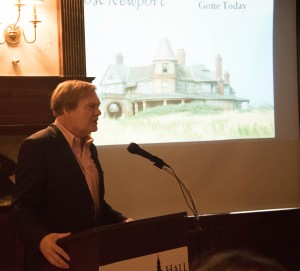
Newport and Lenox had shared families, architects and roles in the Gilded Age. They also differed in several important ways that had impact on their future. We were fortunate to have had the two Gilded Age resorts compared in a June 2, 2015, lecture by Paul Miller at Ventfort Hall.
Newport and Lenox Families
Some families had homes in both places. For instance, Samuel Gray Ward (1817-1907) first built a home in Lenox (Highwood – considered one of the first cottages) in 1844 then a home in Newport in 1850. His Newport property was later sold to Edith Wharton.* One of the demolished Newport houses Mr. Miller described, Pen Craig, had been built by Mr. and Mrs. George Jones, Edith Jones Wharton’s parents.
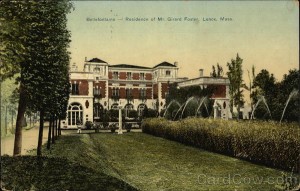
Mrs. Giraud Foster’s (Lenox’s Bellefontaine) sister had a home in Newport and the two families often spent summers in Newport and fall in Lenox.
And there were, of course, the ubiquitous Gilded Age Vanderbilt and Astor relatives in both places as well as other resort towns..Bar Harbor, Adirondacks, etc.
Shared Architects and Designers
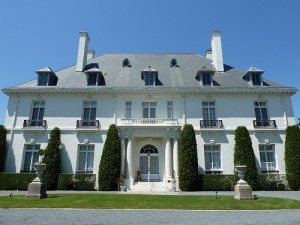
Here are just a few examples of the shared Lenox-Newport talent pool.
Anna Van Nest Gambrel (1865-1927) used Carrere and Hastings, as did did her sister Mrs. Foster for Bellefontaine in Lenox.
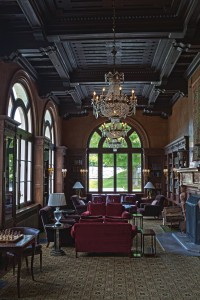
The sisters also used the same interior decorator, Jules Allard (died 1907), the most celebrated interior “decorateur” of America’s Gilded Age.
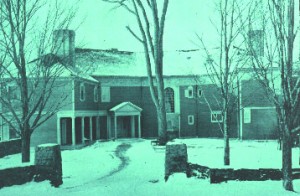
Frequent Newport architect Charles McKim (later partnered with Sanford White) courted and married his client, Julia Amory Appleton (1859-1887) for whom he designed Homestead in Lenox, a leading example of the Colonial Revival style of architecture.
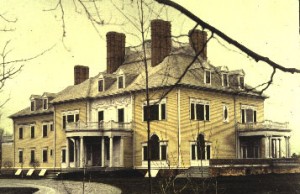
 Edith Wharton’s friend and initial collaborator on The Mount, Ogden Codman, designed (now demolished) Villa Rosa in Newport.
Edith Wharton’s friend and initial collaborator on The Mount, Ogden Codman, designed (now demolished) Villa Rosa in Newport.
Lenox and Newport Differences and Similarities
Unlike Lenox, which remained a frontier town until 1767 and never became a major commercial center, Newport was settled as early as 1636 and becme a thriving port city. It’s path from Colonial port to wealthy watering hole was quite different from Lenox’s path from county seat to Gilded Age resort.
Newport suffered decline after the Revolution because it had been occupied by the British from 1776 to 1779, and over half of the town’s population fled. This occupation had done irreparable damage to Newport’s economy. In the early 19th century the city was forced to re-invent itself. Newport had been bypassed by industrialization and its landscape became frozen in time. Ironically, this became an asset for the town as it transformed itself into a summer resort.
The large tracts of farmland in Lenox, which also had been largely bypassed by major development, were very attractive to the wealthy cottagers. In contrast, Newport was already somewhat “suburbanized” and many of its luxurious mansions were built on smaller lots than their Lenox counterparts.
Like Lenox and the General Electric employees who enjoyed living here, Newport had a major employer who left in the 1970’s — forcing the town to re-think itself once again. The US Navy had had major facilities in Newport beginning after the Civil War. By World War I, estates and resorts on Aquidneck Island were being replaced by Navy facilities and mansions were torn down to make way for housing developments.
Like Lenox, many of the mansions that survived to the mid 20th century were converted for use by schools or other institutions.
While Lenox’s re-invention as a tourist destination seems to have been built on cultural events (Tanglewood) and open land, Newport’s is primarily based on history and ocean recreation.
After World War II, one of the most successful historic preservation movements in the country saved hundreds of structures throughout Newport County. That effort began in the 1840s when George Champlin Mason fought to save Trinity Church. He helped found the Newport Historical Society, which preserved the Seventh Day Baptist Meeting House in 1884, and later acquired and restored the Wanton-Lyman-Hazard House, and the Great Friends Meeting House. Other groups who have taken the preservation movement to heroic levels include the Preservation Society of Newport County, the Newport Restoration Foundation, and several grassroots organizations such as Operation Clapboard.
With the success of the preservation movement, Newport began to recover from the economic downturn that came when the destroyer fleet was pulled out of Newport. A new kind of tourism – now referred to as “Heritage Tourism”- began to develop slowly. Visitors to Newport now come to learn about the area’s remarkable history as well as to enjoy the beauty of the ocean.
*“The Houses of the Berkshires, 1870-1930,” by Richard S. Jackson Jr., and Cornelia Brooke Gilder, Acanthus Press
Also
“Lost Newport, Vanished Cottages of the Resort Era,” by Paul F. Miller, Applewood Books
History of Newport, Newport Historical Society
